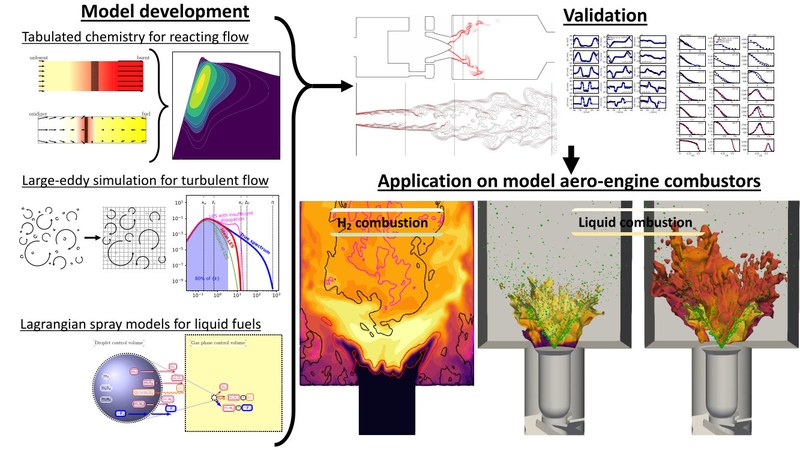PhD work about the application of the modeling of turbulent combustion in model aero-engine burners
Jul 03, 2023
Ambrus Both defended his thesis co-supervised by Daniel Mira and Oriol Lehmkuhl on June 29th at the Campus Nord of UPC. Titled "High-fidelity numerical simulations of reacting flows with tabulated chemistry," the thesis presents a framework of tabulated chemistry methods for the modeling of turbulent combustion and its application in model aero-engine burners.
In the transition to net-zero carbon emission technologies, turbulent combustion is expected to retain an important role in various applications. In particular, the aviation industry is projected to widely adapt the usage of biofuels and hydrogen-based fuels in the coming decades, while the regulations concerning non-CO2 pollutant emissions are becoming more stringent. This transition entails both the gradual evolution of existing burner technologies, and the exploration of revolutionary new concepts. Large-eddy simulation of these combustion systems provides valuable insight into complex dynamic phenomena, such as flame stability and pollutant formation, thus it is an increasingly more important component of the engine development process. Such high-fidelity simulation approaches need to be further developed, gaining confidence in their applicability and exploring their limitations, while keeping in mind the complexity of available high-performance computing resources. This dissertation presents the development of computational tools for the study of multiphase reacting flows, and their application on model aero-engine combustors.
Specifically, the present work applies tabulated chemistry methods for combustion modeling, which allow for the representation of complex chemical phenomena while keeping the computational cost feasible. Furthermore, liquid fuel droplets are modeled in a Lagrangian manner, giving an intuitive representation of sprays. Stand-alone computational tools are created to facilitate the user friendly flamelet calculation and tabulation in a unified framework, and to increase confidence in droplet evaporation models through single droplet simulations. Meanwhile, a high-fidelity simulation method is implemented in the multi-physics simulation code: Alya, utilizing the various preexisting code elements, and exploiting the ongoing development efforts of a large team. In particular, the low-dissipation Navier-Stokes solver of Alya is extended here to variable density flows under low Mach number conditions. This Navier-Stokes solver is coupled with arbitrarily complex thermo-chemical tables in a new framework.
The developed stand-alone tools are used in this work to analyze the single droplet behavior, and to explore steady and temporally evolving laminar flamelets, and their applicability to chemistry tabulation. Subsequently the new framework of Alya is validated extensively and it is used in the analysis of tabulated chemistry methods. The turbulent combustion process in model aero-engines is studied with the developed method at atmospheric pressure. The flame stabilization phenomenon is analyzed in a swirl stabilized technically premixed hydrogen burner approaching flashback conditions. This turbulent hydrogen flame is studied using a perfectly premixed assumption and considering mixture fraction stratifications as well. Subsequently, the Cambridge swirl bluff-body burner is studied under different conditions. A non-premixed gaseous methane flame and two spray flames using n-heptane and n-dodecane fuels are simulated close to the lean blow-out limit, studying the shear induced localized extinction in detail. The prediction of this finite rate chemistry effect is a challenging task for the applied tabulated chemistry methods, however valuable insight is gained on the applicability of different thermo-chemical manifolds, and on the effect of the liquid fuel behavior.
Overall, the implemented low-dissipation finite element method is capable of predicting complex unsteady combustion phenomena, despite the simplicity of the tabulated chemistry methods. The work presented herein has been published in two peer reviewed journal articles and several conference contributions. The developed simulation framework enables the further study of industrially relevant combustion systems using high-performance computing resources.

Share: